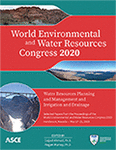World Environmental and Water Resources Congress 2020
Evaluation of Amending Compacted Residential Soils with Compost on Nutrient Leaching
Publication: World Environmental and Water Resources Congress 2020: Water Resources Planning and Management and Irrigation and Drainage
ABSTRACT
Currently, approximately 1,000 people per day move to Florida and based on 2035 demand, the Central Florida Water Initiative projects the resulting regional deficit will be 250 million gallons per day. New residential landscapes are often installed on compacted (bulk densities > 1.60 g/cm3), low-quality fill material with limited water holding capacity and nutrients. Incorporating organic amendments has been shown to mitigate compaction and improve soil quality. The goal of this study was to reduce landscape irrigation to new residential lawns and assess any water quality impacts of amending soils. This study was located in central Florida (Ocala) in the landscapes of 24 homes within an active adult community. Homes were constructed between 2017 and 2019. Data collection began during summer 2018 and will run through the end of 2020. Before landscape installation, one of three treatments [compacted (null), tilled, tilled with compost amendment] were applied just before empire zoysia turfgrass was installed. Soil moisture sensors were installed in 12 of the 24 homes to record volumetric water content within the top six inches. Lysimeters were installed in the backyards of all the homes to collect leachate to evaluate potential nutrient leachate to groundwater. Storm drains were instrumented with weir boxes, water level loggers, and autosamplers to measure and sample runoff. Water quality samples were analyzed for nitrogen species and phosphorus. Results from this study will be used to inform local government development and water resource policies.
Get full access to this article
View all available purchase options and get full access to this chapter.
REFERENCES
Bartens, J., Day, S. D., Harris, J. R., Dove, J. E., and Wynn, T. M. (2008). “Can urban tree roots improve infiltration through compacted subsoils for stormwater management?” J. Environ. Qual., 37(6), 2048–2057.
Baum, M. C., Dukes, M. D., and Miller, G. L. (2003). “Residential irrigation uniformity and efficiency in Florida.” ASAE Paper No. FL03- 100, American Society of Agricultural Engineers, St. Joseph, Mich.
Bean, E. Z., and Dukes, M. D. (2014) "Effect of amendment type and incorporation depth on runoff from compacted sandy soils." Journal of Irrigation and Drainage Engineering 141.6: 04014074.
Carr, M. H. and Zwick, P. D. (2006). Florida 2070 Mapping Florida’s Future – Alternative Patterns of Development in 2070. Retrieved from http://1000friendsofflorida.org/florida2070/wp-content/uploads/2016/09/florida2070technicalreportfinal.pdf
Central Florida Water Initiative. (2015). Central Florida Water Initiative (CFWI) Regional Water Supply Plan (RWSP): Volume II – Solutions Strategies. http://cfwiwater.com
Cogger, C. G. (2005). “Potential compost benefits for restoration of soils disturbed by urban development.” Compost Sci. Util., 13(4), 243–251.
Gregory, J. H., Dukes, M. D., Jones, P. H., and Miller, G. L. (2006). “Effect of urban soil compaction on infiltration rate.” J. Soil Water Conserv., 61(3), 117–124.
Haley, M. B., and Dukes, M. D. (2007). “Evaluation of sensor based residential irrigation water application.” 2007 ASAE Annual Meeting. American Society of Agricultural and Biological Engineers.
Huntington, Thomas. (2007). “Available Water Capacity and Soil Organic Matter.” Encyclopedia of Soil Science, Second Edition. Taylor and Francis: New York, Published online: 12 Dec 2007; 139-143.
Kozlowski, T. T. (1999). “Soil compaction and growth of woody plants.”Scand. J. For. Res., 14(6), 596–619.
Langmaack, M., Schrader, S., Rapp-Bernhardt, U., and Kotzke, K. (1999). “Quantitative analysis of earthworm burrow systems with respect to biological soil-structure regeneration after soil compaction.” Biol. Fertil. Soils, 28(3), 219–229
Milesi, C., Elvidge, C. D., Dietz, J. B., Tuttle, B. T., Nemani, R. R., and Running, S. W. (2012). "A strategy for mapping and modeling the ecological effects of US lawns." J. Turfgrass Manage 1.1: 83-97.
Mitchell, M. L., Hassan, A. E., Davey, C. B. & Gregory, J. D. (1982). “Loblolly pine growth in compacted greenhouse soils.” Trans. Am. Soc. Agric. Eng. 25: 304–307, 312.
Multiquip (2011). “Soil Compaction Handbook.” Retrieved from http://www.multiquip.com/multiquip/pdfs/Soil_Compaction_Handbook_low_res_0212_DataId_59525_Version_1.pdf
Nation Resources Defense Council (2010) “Climate Change, Water, and Risk: Current Water Demands Are Not Sustainable.” Retrieved from https://www.nrdc.org/sites/default/files/WaterRisk.pdf
Pitt, R., Harrison, R., Henry, C., Xue, D., and O’Conner, T. (1999).“Infiltration through disturbed urban soils and compost-amended soil effects on runoff quality and quantity.” Rep. No. EPA/600/R-00/016, U.S. EPA, Washington, DC
Shober, A. L., and Toor, G. S. (2008) "Soils & Fertilizers for Master Gardeners: Urban Soils and their Management Issues." (SL276). Gainesville: University of Florida Institute of Food and Agricultural Sciences. Retrieved December 15, 2019 from http://edis.ifas.ufl.edu/pdffiles/mg/mg45600.pdf
Soil Survey Staff, Natural Resources Conservation Service, United States Department of Agriculture. (2013) Web Soil Survey. Available online at the following link: https://websoilsurvey.sc.egov.usda.gov/. Accessed [12/15/2019].
Solley, W. B., Pierce, R. R., and Perlman, H. A. (1998). “Estimated use of water in the United States in 1995.” United States Geological Survey Circular 1200, USGS, Reston, Va
U.S. Census Bureau (2018). Percent Distribution of New Privately Owned Residential Buildings Completed in Permit-Issuing Places in 2018 by Number of Months from Start. Retrieved from https://www.census.gov/construction/nrc/pdf/pct_start_to_comp_2018.pdf
Information & Authors
Information
Published In
World Environmental and Water Resources Congress 2020: Water Resources Planning and Management and Irrigation and Drainage
Pages: 78 - 90
Editors: Sajjad Ahmad, Ph.D., and Regan Murray, Ph.D.
ISBN (Online): 978-0-7844-8295-7
Copyright
© 2020 American Society of Civil Engineers.
History
Published online: May 14, 2020
Published in print: May 14, 2020
Authors
Metrics & Citations
Metrics
Citations
Download citation
If you have the appropriate software installed, you can download article citation data to the citation manager of your choice. Simply select your manager software from the list below and click Download.
